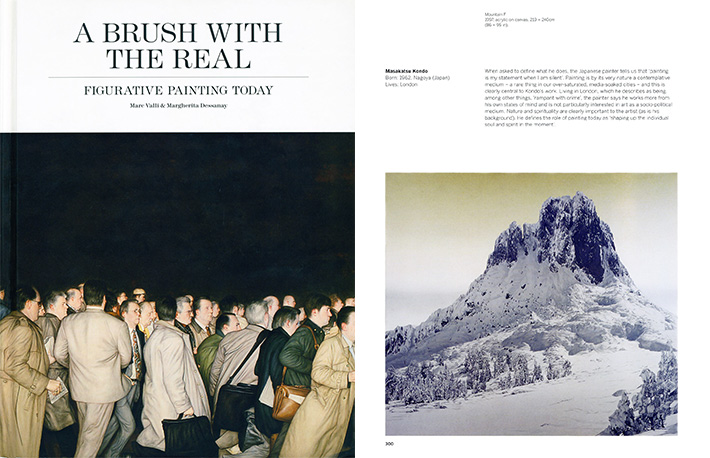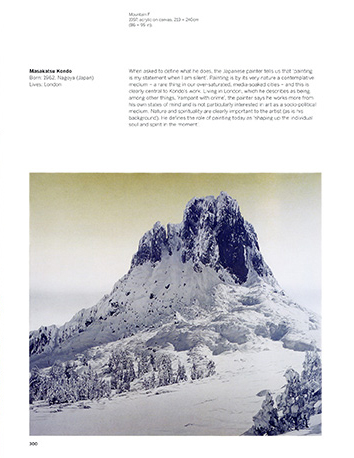

A BRUSH WITH THE REAL
FIGURATIVE PAINTING TODAY
MarcValli and Margherita Dessanay
Laurence King Publishing Ltd 2014
ISBN:978 178067 2830
www.laurenceking.com
Neo-traditionalisrn, looking at the past or the future, Thought systems, Imaginary scenarios, Utopias, Dreams
MASAKATSU KONDO
When asked to define what he does, the Japanese painter tells us that ‘painting is my statement when I am silent’. Painting is by its very nature a contemplative medium — a rare thing in our over—saturated, media—soaked cities — and this is clearly central to Kondo’s work. Living in London, which he describes as being, among other things, ‘rampant with crime’. the painter says he works more from his own states of mind and is not particularly interested in art as a socio—political medium. Nature and spirituality are clearly important to the artist (as is his background). He defines the role of painting today as ‘shaping up the individual soul and spirit in the moment’.
Background
As a child I grew up in a farmer’s family. I used to run around fields and scenic mountains. I was lost in the fascination of nature, looking at animals, trees and catching insects and I would run home when it got dark. There are lots of animistic stories based on Shintoismand Buddhism, and these have urged me to gain a deeper relationship with nature.
I wrote a statement for my painting Mountain F, which I think neatly summarizes the relationship between my background and my paintings:
‘When I grew up as a child in Japan, on a clear winter day, one could see the mountains called Sanage—yama to the east and Ibuki—yama to the west. And just north of our town, there was a small hill with three black boulders, one of which had a footprint—Iike indentation. The local legends had it that a mythical goblin called Tengu used this as a stepping—stone to jump across from Ibuki—yama to Sanage— yama. As a child I knew this to be a made—up story but I remember pondering over the legend from time to time when I gazed upon these mountains as I played.
The work is based on an actual mountain in Tasmania but the image in my painting is affected by how I see those mountains in my mind.’
Traditional Japanese art
I am very interested in the way Noh (Japanese traditional theatre) expresses mythological stories in codified form with symbolic masks and costumes, especially in describing the passage between reality and the afterlife. Something that excites me is the way Noh reconfigures abstract events.
I have great admiration for Hokusai; I hope I can live to 90 [years old] and keep progressing like him. I feel his language of simplified subjects and strong compositions manages to summarize a certain perception of reality, and his way of stripping down his choice of colour is always fascinating. Yet somehow the element of life is still breathing within his visualization.
Scene
Having lived more than 20 years in London, I feel I do not belong to any particular scene. I feel some isolation, but I’ve become comfortable with the situation; in fact, I feel liberated and my sorrow becomes a faint freedom. Maybe this has become the central element of my identity.
Process, subject matter and style
Many paintings are based on my own memories but I look for clues in actual photographs (a photograph that matches my own memory). I hope I am not confined to one style: I prefer to work through a certain mood and feeling instead of being focused on one style. Technique is constantly developing with each painting. Different subjects will function as triggers for the evolution of technique and style. I sometimes find interesting results from unexpected material events. In order to obtain this, I have moments of hard negotiation or painful failure. All this process is very important for every painting I work on.
The choice of subject matter is drawn from a metaphysical plot, or idea, while its realization is mostly the product of chance or fate. In this abstract conversation I find clues in books (often encyclopedias), films, TV I can then project my feelings on to these images and play around with the drawings I make of them. It becomes a subject when it changes itself from a strong impression into a reality. But really the image is only crystallized in the daily practice of painting on the canvas.
Painting as a journey
A big painting can take about a month or two, but it is never a routine. Each painting has its own journey. I am willing to take the risk of experimenting and accepting the displacement of material accidents on canvas. Through instantaneous decisions. failures, emotional pain, verifications, I will progressively get closer to the abstract objects in my mind that I have been holding on to as the subject. Contemplation of nature plays an important part.
I hope my paintings are never a conclusion, and that they just open up a space. They consist of layers of consciousness and unconsciousness, events and phenomena recurring behind my eyes.
On the role of painting
Art is never hemmed—in by a subject, it is an opportunity for travelling into images. I keep visiting the gallery to look at them intensely to confirm what’s there what I can feel instead of what I can read. Paintings force you to have a physical relationship in space as well as involving you, forcing you to check details, layers and senses.
筆による実在表現(Real) — 具象画の現在
著:マーク バリーイ, マルゲリータ デッサーネイ
ネオトラディショナリズム– 過去と現在を見据えた思考システムから ユートピア、夢、そして空想の世界へ。
近藤正勝にどんな作品を作っていますか?と訊ねると、 『ペインティングは私が無言でいる時のステートメント(声明文) のようなものです』と答えました。
近藤の仕事(絵画) は本質的に黙想性を内包するメディウムであるペインティングです、その現在における絵画の役割を、個人の心の状態また精神をその時々で色や形に置き換えることであると定義しています。彼はとりわけ美術作品が政治や社会問題を扱うことに興味がありません、それよりも自己の身体や心、また思考の状態から作品は生み出されていると語っています。彼のバックグラウンドが示すように、明らかに作家にとっては自然やその精神が重要な作品の要素となっていると考えられます、しかしその背後に見て取れるものは、飽和状態にあるマスメディアに溢れる現代社会の問題などです、それはきっと彼の住んでいるロンドンが過渡な情報社会であり、犯罪が横行する環境であるがゆえに必然的に現れて来るのでしょう。
*バックグラウンド
農家で育った私は、いつも美しい野原や山を駆け回り、時間のたつのを忘れて野原を駆け巡って昆虫を採たり色々な動物を見て回っていました、そして暗くなると急に怖くなって家に走って帰るのです。 日本には神道や仏教思想のもと多くのアミニズム的な物語があます、これらのお話は私が自然をより深く理解するために大切な要素となってきました。
下記の文章は以前 Mountain F という作品のために書いたものです、これがきっと私の生い立ちと私の作品の関係を旨く言い示しているとおもいます。
『 日本で生まれ育った私のふるさとでは、空の澄み渡る冬の日に、町の西に伊吹山、東に猿投山とうい山が見えました。そして町の北に小山があってそこに三つの大きな石が有りました、不思議なことにその石の一つには足跡が刻まれていたのです。地元の伝説では、天狗様が伊吹山から猿投山へ飛んで行く時に踏み台として使った石だと言うことでした。私は子供ながらそんな話は嘘だと直感していましたが、それらの山を見るたびにこのお話に思いを巡らせて遊んでいたのです。』
この作品Mountain F は実際にはタスマニヤの山を素材としていますが、作品の根底には私が子供の頃に見たあの山々が有るのです。
*日本の伝統芸術
わたしは能という日本の伝統舞台芸術に大変興味を持っています。そこではとても抽象的な問題を内包した神話や伝説など、特に生と死を行き来する様な物語をシンボリックな能面や衣装とともに演者が舞台芸術として再構成して見せてくれます。
また、葛飾北斎は本当に大好きです。できれば彼のように90歳まで生きて作品をつくりつづけたいものです。彼の凄さはリアリティーを担保したままその題材を簡略化し力強い構図で描き出し、色づかいもできる限り厳選しているにも関わらず、森羅万象の細かな要素まで息づいて感じられるような絵画的言語を確立しているところです。
*シーン
私はもう20年以上ロンドンに住んでいます。最近では日本人だとかイギリス人だとか、どこかのシーンに所属している気がだんだん無くなってしまってある種の孤独感を感じています。でも一旦この孤独感に慣れてしまうと、孤独の痛みは逆に微かな開放感と共にとても自由な気分を私に与えてくれるのです。この感じがきっと私自身のアイデンティティの大きな一部となっているのでしょう。
*制作の過程、また題材とスタイル
私の作品(Painting)は自身の記憶に密接な関係を持っています、実際には記憶の奥にあるものを触発する写真(イメージ) などを探して作品に引用します。一定の描く方法(technique and style) にこだわること無くむしろ特定の感覚やムードといったものを探していきます。新しい作品(Painting)を作る時には選択した題材(subject matter) から誘発される新たな技術的発見を常に受け入れながら前に進んで行き、時には素材(material) の特性が全く期待をしていない結果に導いてしまうこともあるので、毎回粘り強い考察を重ねながら一歩一歩すすめて行くことがとても大切です。それでも時にはがっかりするような失敗となってしまいます。
題材(subject matter) は形而上学的な意味での世界の普遍的な原理のもと、全くの偶然かまたは運命的な必然の選択だと感じています。この抽象的なやり取りの中、たいていの場合その手がかりを本(百科事典) やテレビ、ネットまた映画と言ったマスメディアから見つけることができます。その写真を元にドローイングなどを何度も繰り返し、ある種のリアリティーを内包したイメージを探して行きます。しかし最終的にはキャンバスの上での日常的制作行為-葛藤と選択を繰り返して- 絵画として結晶化する瞬間を迎えます。
*絵画は旅
大きな作品はたいてい1~2ヶ月をかけて制作します。その過程では毎度リスクおって素材の可能性を探る実験をしながら、新しい発見を求めて進めるようにしています、常に検証をしながら感情的な苦痛を感じたり失敗をしたりしながら、私が心の中に握りしめている対象(subject matter) に秘められた抽象的な感覚に迫って行きます。そこでは常に自然の法則を見据えた瞬時の意思決定が必要です。それはまるで全く知らない国を旅するのにとても似ています。
私は自身の作品(Painting) が何かの結論を示すものでは無いように願っています。それよりもただ解放されたスペースがそこにあれば良いと感じています。そして見ること(意識と無意識の階層が構成する) の先に繰り返し確認できる現象(phenomena) と事象(event) を楽しむことができればといいと思います。
*絵画の役割
アートは題材(Subject) だけによって制約されるもではありません。題材(Subject) はイメージへ入って行くための入り口であり、旅を始めるきっかけなのです。私はよくギャラリーへ行って歴史的な名画を見て回ります、 そこで何が読み取れるのかを考えるのではなく、何を感じとることができるのか-凝視します。空間における絵画は我々と強制的な物質的関係にあり、そこで絵肌や重なりなどのディテールを確認させようと私たちの感覚に直接呼びかけて来るのです。